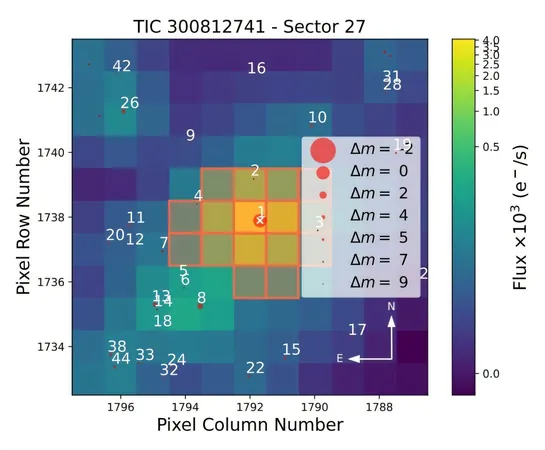
Astronomers Uncover Two Earth-Sized Rocky Exoplanets Orbiting a Nearby Star
2025-09-02
Author: Daniel
New Discoveries in the Cosmos!
Hold onto your telescopes! NASA's Transiting Exoplanet Survey Satellite (TESS) has just unveiled two astonishing rocky exoplanets orbiting a nearby K-type star known as TOI-2322. These new worlds, comparable in size to Earth, promise exciting potential for future exploration.
What We Know About TOI-2322
Located about 195 light years away, TOI-2322—also referred to as TIC 300812741—is a K4 spectral type star that has captivated astronomers. Observations from TESS between 2018 and 2023 revealed intriguing transit signals in the star’s light curve, indicating the presence of these exoplanets. A dedicated team of researchers led by Melissa Hobson from the University of Geneva confirmed these findings with advanced follow-up observations.
Meet the Exoplanets!
First up is TOI-2322 b—a rocky planet with a size similar to Earth and a mass under 2.03 times that of our home planet. This intriguing world completes an orbit around its star every 11.3 days, sitting just 0.09 AU away from TOI-2322. With an estimated equilibrium temperature of 603.1 K, it could hold the ingredients for fascinating studies.
Next, we have TOI-2322 c, the larger of the duo. This impressive exoplanet has a radius approximately 1.87 times that of Earth and a staggering mass around 18 times greater. Found 0.13 AU from its star, it takes 20.2 days to orbit and boasts an equilibrium temperature near 500 K. Its density, a hefty 14.69 g/cm³, suggests a robust, Earth-like internal structure.
A Unique Stellar System
The TOI-2322 system is a remarkable laboratory for astronomers. The host star is about 30% smaller and less massive than our sun, with an age of approximately 3.9 billion years. Surprisingly, the star’s rotation period of 21.28 days nearly matches the orbital period of TOI-2322 c, which could complicate the detection of additional transiting planets.
The Future is Bright!
These discoveries not only enhance our understanding of rocky exoplanets but also present an excellent opportunity to refine detection techniques for potential future discoveries. As TESS continues its mission, the universe just keeps getting more fascinating!





 Brasil (PT)
Brasil (PT)
 Canada (EN)
Canada (EN)
 Chile (ES)
Chile (ES)
 Česko (CS)
Česko (CS)
 대한민국 (KO)
대한민국 (KO)
 España (ES)
España (ES)
 France (FR)
France (FR)
 Hong Kong (EN)
Hong Kong (EN)
 Italia (IT)
Italia (IT)
 日本 (JA)
日本 (JA)
 Magyarország (HU)
Magyarország (HU)
 Norge (NO)
Norge (NO)
 Polska (PL)
Polska (PL)
 Schweiz (DE)
Schweiz (DE)
 Singapore (EN)
Singapore (EN)
 Sverige (SV)
Sverige (SV)
 Suomi (FI)
Suomi (FI)
 Türkiye (TR)
Türkiye (TR)
 الإمارات العربية المتحدة (AR)
الإمارات العربية المتحدة (AR)